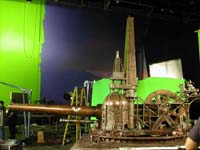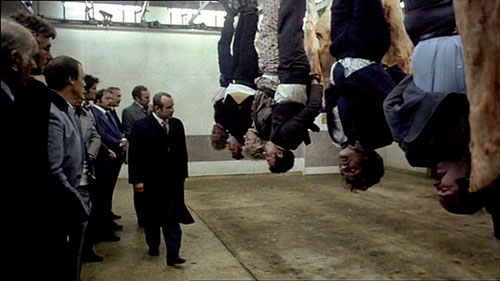Dynamation is a term which was coined by producer Charles Schneer when we started making black and white films together in the 1950s. We specialised in combining live actors with animated models and, since nobody knew quite what stop motion photography was, they would call it an animated film. We were trying to establish a new division between cartoon and three-dimensional animation, so we came up with the word ‘Dynamation’ for that process. As the years went by, the publicity department felt that they had to enhance the word, so we got ‘Super Dynamation’!
Georges Meliés experimented with stop motion photography in France before 1900 with his unique short film Trip to the Moon but it was Wilis O’Brien in America who first found a commercial use for stop motion. His greatest triumph was King Kong which set me off and I have never been the same since!
It left such an impression on me that I felt it was the type of career I wanted, so I made it my business to find out how it was done – hence Dynamation sprang out of the basic O’Brien technique.
The principle behind the technique is that we project a small picture of the live action. Unlike many companies who build 50ft models, we build small models and shrink the actors down to size in order to have control. The larger you go with complicated hydraulically controlled mechanisms, the less control you have – particularly in dramatic situations – so we use a small rear-projected image of the live action behind the animated model, sometimes adding matting process.
When we were presented with the story of Gulliver’s Travels’ we wanted to make it as inexpensively as possible. We had heard of the yellow backing travelling matte process used in England at that time (1959) making its own matte instantaneously using a bi-pack camera. We thought that would simplify combining big people with little people. Since we had planned 150 travelling matte shots, we came to the UK to investigate and we have been here ever since. We used the yellow backing system on three pictures, then it suddenly went out of fashion. That was the darkest day I can remember. Now, of course, we use the blue backing system.
We had just perfected the miniature projection duping process for Twenty Million Miles to Earth where you could hardly distinguish between the original negative and the Dynamation shots – and I would have liked to do the next picture that way – but Charles Spooner said you could not shoot an ‘Arabian Nights’ type picture in black and white, so we made The Seventh Voyage of Sinbad in colour. This took some experimenting as we did not have a choice of colour film which we could use for back projection plates. However, we took the plunge and it worked out quite well commercially. Not too many people found it objectionable to see rather grainy Dynamation shots intercut with the original negative. People who are technically minded are far more aware of that than the average cinema audience, although audiences today are very astute and certainly do not accept things that they would have done twenty years ago.
One of the biggest problems with colour film is contrast and change of colour and we found that the new low contrast print film, designed mainly for television, was very useful. It is much easier to control the colour balance today than it was back in 1958, when you could not leave an unfinished shot in the camera overnight. If you did, it was quite evident the next day to see a colour change jump due to the California temperature drop during the night.
Many times I set my own challenges and I find that my goal is always a little too high for the assets we have. I think that one of my greatest challenges was in Jason and the Argonauts where three men fight seven skeletons. That sequence presented a lot of problems and there were times when I averaged about thirteen frames per nine-hour day – which is less than one foot of film. The accountants got very uptight because they expected me to grind out the footage very much faster than that!
It was necessary for me to handle all the skeletons myself as they had to be synchronised very intimately with the three miniature-projected swordsmen. The skeleton’s feet had to be fastened to the floor and, the minute they left the ground, I had to suspend them on wires for accurate control over the animation. Being keen to make the skeletons look professional, I studied fencing myself but unfortunately, I threw my hip out of joint and had to give it up!
The whole fencing sequence had to be choreographed like a ballet and broken down into numbers. We had to pre-plan the cuts ahead of time through the storyboard – and I cannot stress enough how important that it. When you get on the set you do no want to have a lot of arguments and discussions on how shots should be set up. I always make a number of pre-production drawings which aid everyone concerned in visualising just what the final effect will look like on the screen.
I always prefer to animate models of animals for exotic settings and situations instead of using real animals. It is so difficult to find a talented crab who will perform just the way you want, or a baboon who can play chess! You do not want to be at the whim and mercy of a lizard, hoping he will go from point A to point B in so many seconds. I find that real lizards become lethargic under the hot studio lights and barely blink or yawn for the benefit of the camera. The animated ones will perform exactly as directed.
For the bulk of the shots in our films I prefer to use miniature rear projection instead of travelling mattes because it’s easier to execute intimate interplay between actor and model. You have the projected image right there in front of you, rather than wait for weeks to see the combined effect from an optical printer. However, we do resort to many travelling matte shots which, in themselves, are very time consuming to put together.
Dynamation is a word which really means using every trick in the trade – but there comes a point in the economics of doing stop motion animation where you cannot do as much as you would like to do in the way of retakes and careful matching. The time factor is quite considerable. The ideal situation in the future is the Chroma Key method as used in television. When this method has the same resolution as film, you will be able to make instantaneous travelling mattes. I believe that some companies are working on this at the moment.
In recent years there has been a great exposé of the ‘behind the scenes’ details of making complicated special effects. It is my belief that it rather spoils the illusion when the audience is told how it is achieved. It is like a stage magician who tells everyone how he achieves his illusions of magic – soon the audience loses interest in the show!


































